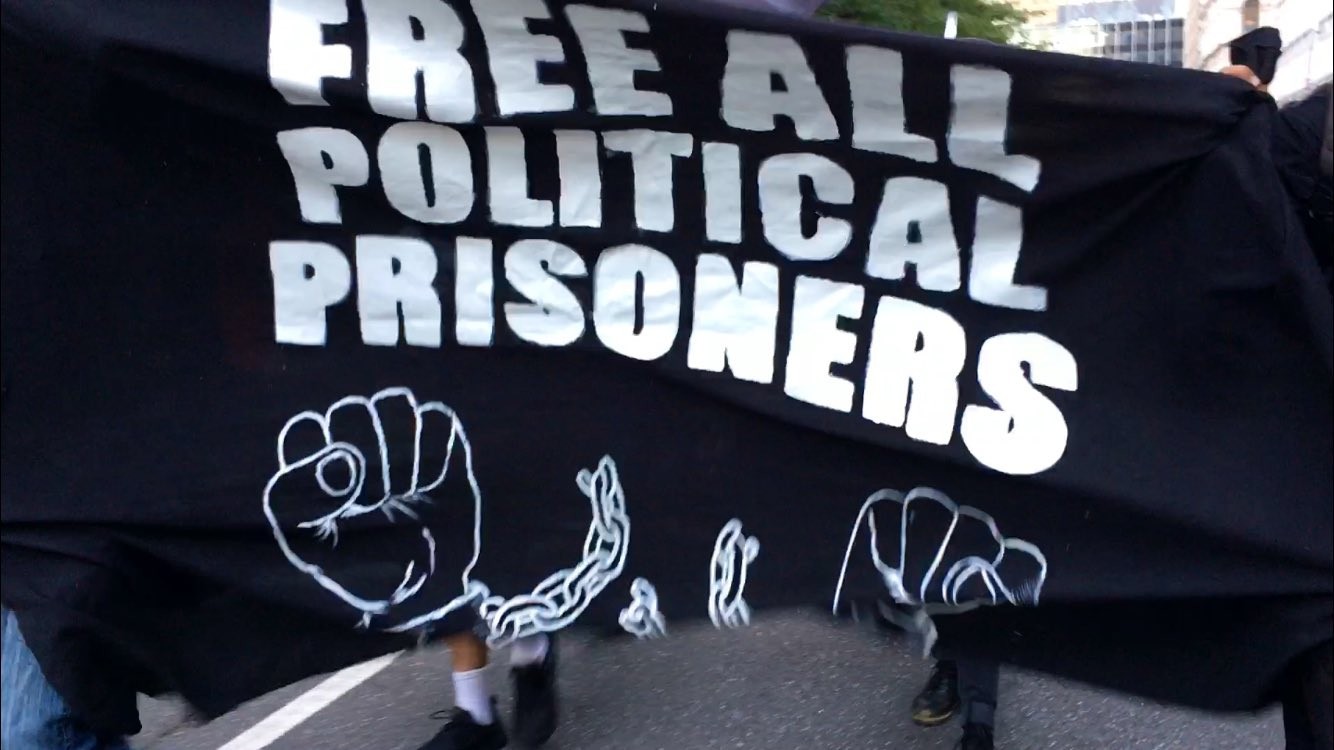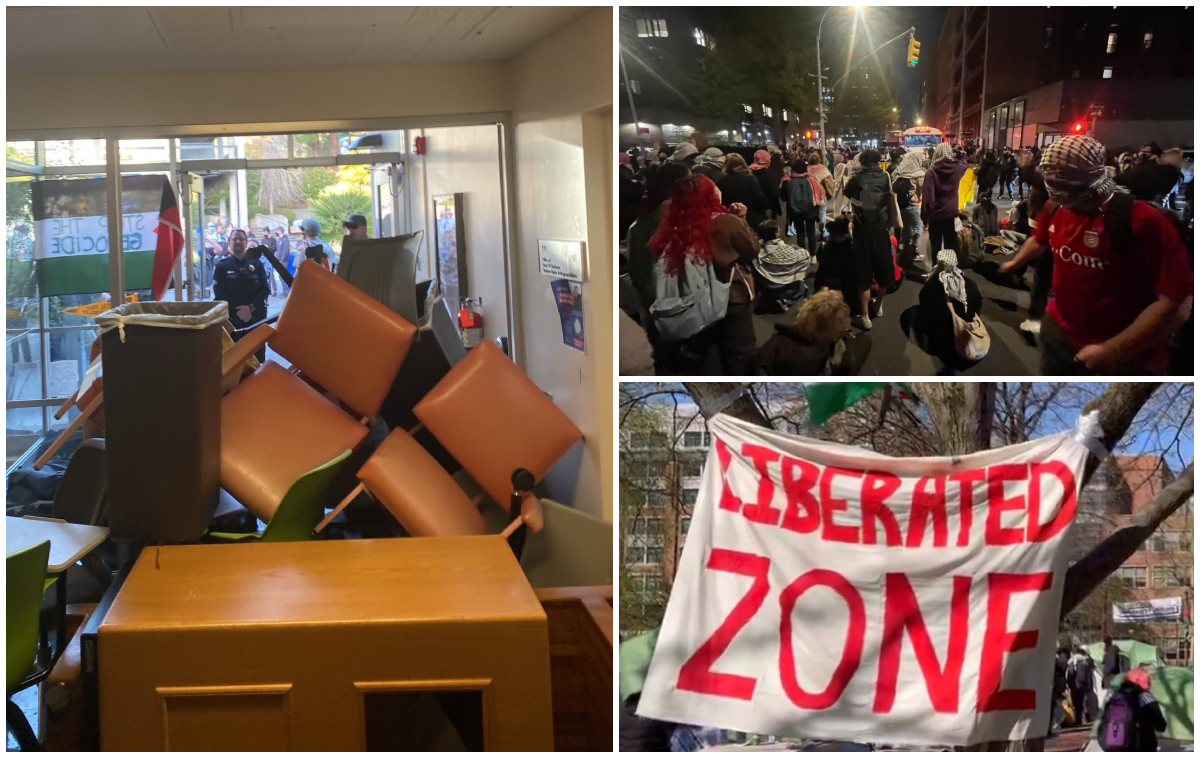Filed under: Analysis, Anarchist Movement, Featured, Northeast

A report and analysis from New York on the recent wave of revolt and rebellion and why it has managed to continue past its initial explosions.
photo via Ash J
On September 4th, a black bloc of roughly two hundred people stormed through downtown Manhattan, leaving a trail of barricades, broken windows, and burning trash in its wake. When riot police finally mounted a charge, the bloc dispersed as quickly as it had materialized. There were eight arrests. The next morning, the New York Post reported that there were $100,000 in property damage.
Before May 2020, this night would have felt historic. (The last black bloc in New York was probably in 2014, but one would be hard pressed to name when the last approaching this magnitude and intensity occurred). Today, it felt a bit nostalgic. “This almost felt like The Uprising!,” old friends exclaimed, bumping into each other as the crowd dispersed. The fact that so much is still possible after so many months should be enough to shake off the despair so many of our comrades have lately fallen into. This is not yet the moment for despair, but simply an occasion to clarify our perspectives, sharpen our weapons, and perhaps catch our breath. This brief upsurge in activity provides us with an opportunity to hone our perspectives of the situation, and how we might build a revolutionary force within it.
Fierce march took over the streets of NYC earlier tonite demanding #AmnestyForAll protesters arrested during the uprisings. Corporate property got redecorated with abolitionist messages. NYPD tried to follow, but protesters kept them away with barricades. At least 3 arrests. pic.twitter.com/McmjKwdqwB
— Ash J (@AshAgony) September 5, 2020
On July 25th, cities across the country responded to a call for solidarity with Portland. The day revealed the emergence of a new layer of militants across the country. These actions were distinct from both the spontaneous rioting of late May and early June, and the mass social movement that followed it. They showed that, in many cities, a cohort had formed of people shaped by the struggle, and who were now getting organized and groping for methods to push the struggle forward and constitute a revolutionary pole within it. Many of them have few to no ties with preexisting radical milieus in their cities. While the identity of “abolitionist” seems to have as much currency as “anarchist” amongst these militants, they show little interest in either the policy proposals or coalition-building that preoccupied earlier abolitionist formations. This is perhaps why some have begun to refer to this cohort as the “new abolitionists.”
Fascist, cop-loving NYC Councilmember Joe Borelli (who protested in support of the NYPD cop who killed #EricGarner) is unsurprisingly being ignorant & willfully obtuse. pic.twitter.com/urdFhx7OGp
— Ash J (@AshAgony) September 6, 2020
In New York City, both July 25th and September 5th bore witness to a constellation of two hundred or so militants who have been developing a shared intelligence in the streets together and organizing themselves in crews for the last year. In the years immediately before and after Occupy, there were hundreds of anarchists in the city that would reliably respond to a call for militant action, but it has been years since this was the case. If these militants first made their presence felt on July 25th, September 4th showed that this layer is capable of taking its own initiative, and not simply waiting for external events. It further showed that the confidence and trust these militants have in each other and themselves is increasing.
Struggles either intensify, extend, and generalize, or else they exhaust themselves. In this light, the appearance of this militant cohort is a welcome sight. To effectively fill their role and to actually advance the struggle, New York City’s new abolitionists will need to adopt consistency, rhythm, and resonance as their watchwords.
Consistency: These new militants will need to try to find each other, deepen what they have in common, and develop shared projects, perspectives, and debates. This is neither about building an organization or scene, nor is it about heightening sectarian feuds. Rather, it is about building an ecosystem of revolutionary perspectives with room for both debate and collaboration. A revolutionary force is not simply a fighting machine that manifests itself from time to time on the battlefield, but must also be a building, thinking, and living-force. The more circulation there is between points on a network, the more resilient the network is. In the lulls between action, the question will be what can be done to intervene with more strength next time. There will be lulls long enough that comrades will need to find projects to work on, building infrastructure and skills, to keep them organized and prepared over the long haul.
Protesters in Rochester have become organized within just a few days. Here they practice with their shields before approaching the police barricade. #rochester #rochesterprotests #DanielPrude pic.twitter.com/MfjANM0FUZ
— Maranie R. Staab (@MaranieRae) September 7, 2020
Rhythm: Cities that have kept the fires burning the longest have found a consistent rhythm or pace to their actions. This allows momentum to build up. But having a rhythm also gives the movement something towards which to orient itself. If there are hundreds in New York City that have begun to develop a shared tactical sensibility and a desire to act together, they are still waiting for others (crews with more credibility, resources, confidence) to take initiative. Having a shared rhythm allows for much broader self-organization as militants have a framework to take initiative within. Having something they can anticipate and plan around will allow much wider layers of the movement and city (those not already in the know) to participate.
Every struggle that has sustained itself over the last two years has found its own cadence of action. Portland, famously, has developed a rhythm of coming out every night since the beginning of the uprising. The Gilets Jaunes movement in France would converge in Paris for a mass action every Saturday. The struggles in Chile and Hong Kong last year similarly found their food in a shared rhythm. Daily actions may be beyond the capacity of our city’s militant networks for now, but setting a weekly or twice-monthly rhythm may be possible. A bottleneck so far has been that the groups or coalitions that have called previous actions are unsure whether they have the capacity for more frequent actions. This could be resolved by an informal agreement between different networks to rotate responsibility for putting out calls along the same rhythm until that rhythm has been internalized by the movement.
Resonance: The only real power that struggles have is their capacity to disrupt society through direct action. To actually be disruptive, these actions will need to involve and resonate with more than just committed militants. How can this militant pole attract wider layers of society? In particular, how does the struggle extend to the hood?
Social movements, mass organizing, + building relationships out of struggle works, it matters, and it changes people's ideas – even in the face of the massive force of the State, the police, and the corporate media. Don't forget that. https://t.co/ixmaz7cnvb
— It's Going Down (@IGD_News) September 9, 2020
At the highest points in this wave of struggle, young black proletarians were at the tip of the spear; its avant-guarde, before they began to feel themselves marginalized and withdrew from the streets. Their initial presence, to some extent, can probably be attributed to the national mood: people all over the country watched the burning of the Third Precinct and looting in Minneapolis and wanted to do the same where they lived. But first, they had to believe it was possible; the spell of law and order had to be broken. For the first days of the uprising in NYC, a militant multiracial crowd proved themselves willing to take the offensive against police and property, thereby proving that doing so in that moment was possible. It was then that the black proletarian youth came out in a concentrated, organized fashion, storming Manhattan and looting in a dispersed way throughout the boroughs. While it is unlikely this would have happened outside of the national context, it is also unlikely this would have happened without the initiative of a militant minority acting within the city.
An intensification of the struggle will likely have to involve a new encounter between these black proletarian youth and these new abolitionists. Lacking organic ties, this encounter will have to be the product of each acting in a way that resonates with the other.
Through this developing consistency, rhythm, and resonance, through the encounter between the militant minority and the proletarian avant-garde, the contours of the party of insurrection, of anarchy, of communism, becomes legible. In the context of an economy staggering towards collapse, it is through this sequence of riots developing, intensifying, and generalizing, that the question of revolution will be raised in a meaningful way. The only revolutionary perspective today is thus: from riot to insurrection, from insurrection to communism. In this unfolding sequence, those of us who today don the ski mask to feel the warmth of the proletarian community have a small, but significant, role to fulfill.
It may be September, but this long, hot summer is far from over.





